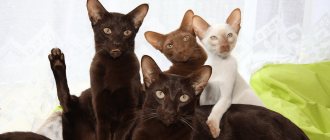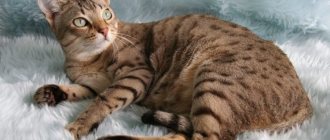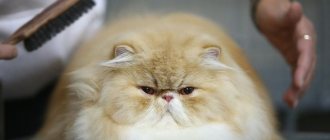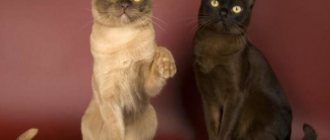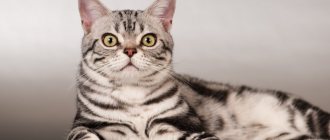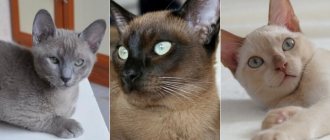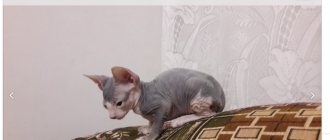Description
The Chilean cat is the smallest wild cat species in the Western Hemisphere, averaging no larger than the average domestic cat. The mass of the kodkod varies from 1.5 to 3 kg, body length from 40 to 52 centimeters, and tail length from 19 to 25 centimeters. The head is small, the tail is thick, the legs are short and equipped with claws that are well adapted for climbing trees. The main coat color is gray-brown or reddish-brown, with dark spots on the body and stripes on the tail, back, sides and legs. The underbelly of the Chilean cat is light in color. Often there are kodkods with dark fur, in which, under normal lighting, you can also see characteristic spots. Chilean cats are similar in appearance to Geoffroy's cats (Leopardus geoffroyi), except that Kodkods have less distinct stripes on the head and shoulder area, and thicker tails.
There are two subspecies of the Chilean cat:
1) Leopardus guigna guigna - found in southern Patagonia and can be identified by its paler coat with no markings on its paws;
2) Leopardus guigna tigrillo - lives in central Chile and is characterized by a smaller body size, brighter color, and spots on the paws.
Recommendations for purchasing a Turkish Anatolian breed
The cost of a purebred “Anatolian” starts from 25,000 rubles. Some sources say that there are individuals for 3,000 rubles, but a Turkish shorthair cannot cost that cheap. The final cost of a kitten depends on the purity of the blood, cattery, pedigree, and color.
In Russia, Ukraine and Belarus, cats are brought from neighboring countries. The breed can be found at exhibitions in Europe, but it is most accessible for purchase in its homeland - Turkey.
When purchasing a kitten, pay attention to its teeth, they should be white and even, the palate should be light pink. The ears are without damage, the eyes are without tearing or suppuration. A healthy animal should have no lumps or growths on its body. The coat is shiny and does not fall out.
Once you bring a Turkish native into your home, you will never regret it. This affectionate and intelligent animal will delight you and your loved ones, becoming a real member of the family.
Habitat
Chilean cats prefer terrestrial and arboreal habitats in moist temperate forests, especially coastal areas, and the islands of Chile. The forest types favored by the Kodkod include: evergreen tropical forests, temperate deciduous forests, sclerophyllous shrublands and coniferous forests. This species of cat is relatively tolerant of changes in habitat, as it can be found in primary and secondary forests, bushes, and also on the border of cultivated areas. Most often, kodkods inhabit the Chilean Valdivian and Araucaria forests. These forest habitats are characterized by: altitude 1900-2500 meters above sea level, complex layers of canopy, bamboo, vines and epiphytes. In addition, Chilean cats are found in Argentinean moist montane forests, which also contain bamboo, vines and epiphytes.
What does a Turkish Shorthair or Anatolian cat eat?
The Anatolians have a good appetite. They can eat all day long without gaining excess weight. This is due to constant activity and good metabolism.
When preparing a diet for your pet, give preference to natural products: boiled beef, fish, fresh chicken mixed with vegetables or cereals, eggs, offal. It is better to refuse fresh milk and give preference to fermented milk products.
Dry food and premium canned cat food can be given infrequently and only to unneutered individuals. But your pet's preference will be on the side of natural products. For good digestion, give cats fresh grass and sprouted oats.
Anatolian cats can be given sprouted oats for good digestion.
Already in the first weeks of life, the kittens’ bodies require more substantial food in addition to mother’s milk. They are fed with fermented milk products. First, the treat is offered to the mother and, if she approves of it, she will allow it to be given to the children. Otherwise, she will not allow the kittens to see him. Babies have a good appetite, so they ask for food often, up to 5 times a day. By the age of three months, they have established a normal diet.
Reproduction
Due to the small number of Chilean cats, information about their breeding is very limited. Large male territories may indicate a search for multiple mating partners.
Typically, litter size varies from 1 to 4 kittens. The gestational (pregnancy) period is 72-78 days. The seasonality of breeding periods is unknown. Sexual maturity in both males and females of the Kodkod occurs at the age of about 24 months.
Little information is known about the care of the offspring. As with other small cats, females provide parental care to the cubs. They invest considerable energy in feeding and long-term nurturing to teach the kittens how to hunt before gaining independence from their mother.
Features of care
The Anatolian cat breed does not require special care. Hygiene procedures are carried out independently. The only thing that is required from the owner is to periodically comb the animal during the molting period so that less hair gets into the stomach.
A bath day is held extremely rarely, about once a month. Only cats that spend a lot of time outside require more frequent procedures. But, if your pet asks to bathe him, do not deny him this pleasure.
Ear care should be performed at least once a week. Use a cotton swab and a special product to wipe the cat’s ears, removing accumulated wax from them. After the procedure, you can lubricate the inner surface of your ears with Vaseline or baby cream. Use a cotton pad soaked in warm water to wipe your eyes. Don't forget to regularly inspect your pet's ears and fur for ticks and fleas. This is especially true for free-roaming cats. Buy anti-parasitic products or a collar for them.
From early childhood, teach your pet to have its nails trimmed. You can leave them in their natural state, but there is a risk of scratched furniture and sofas.
You need to trim the claws very carefully so as not to hurt the nerve. The procedure is performed 3 times a month.
Particularly caring owners of “Anatolians” can purchase toothpaste for animals at a pet store or veterinary pharmacy and brush their pet’s teeth 2-3 times a week. For these purposes, use a soft brush, perhaps a child’s one.
Behavior
Chilean cats are arboreal animals and tend to climb to heights when threatened, or to stalk prey. In areas adjacent to human settlements, kodkods are predominantly nocturnal, but in the wild, they are more often active during daylight hours. They are solitary, predatory animals with larger territories for males than for females.
One study found that the average range for a group of five Chilean cats (one male and four females) was 1.5 square kilometers. Another study estimated the average home range of a kodkod to be 2.69 square kilometers, with significant overlap between individuals. In fragmented habitats, males are more likely to leave their territory than females.
Origin story
The pedigree of the Anatolian breed goes deep into the past. The natural formation of the species occurred in the Armenian Highlands around Lake Van. The ancestors of modern "Anatolians" were domesticated in Eastern Anatolia (now Turkey). Since then, the breed has undergone some changes at the genetic level; modern cats have taken from their ancestors temperament, excellent health and a high level of intelligence.
Today the Anatolian cat is considered the pride of Turkey. It was first shown to Europeans in 1995 at a German exhibition. It was then that breeders became interested in the breed. Having acquired several individuals, they began breeding and after 5 years the “Anatolians” were officially recognized by the WCF cat association.
Nutrition
The Chilean cat is a carnivore. The diet is based on small rodents, reptiles, birds and large insects. Prey species observed include: gray rats (Rattus norvegicus), magellan thrushes (Turdus falcklandii), cayenne pigtails (Vanellus chilensis), robin (Scelorchilus rubecula), black-throated topacolo (Pteroptochos tarnii), greylag geese (Anser anser) and chickens (Gallus gallus). Kodkods sometimes prey on poultry, resulting in direct conflict with humans, often resulting in these cats being killed by farmers.
Character of Anatolians
Anatolian cats are playful, affectionate and very intelligent pets. Usually they choose one owner and prefer to spend as much time as possible next to him. They are curious and strive to take part in everything going on in the house. At the same time, loneliness is tolerated quite calmly.
They are easy to train, quickly remember their nickname, and can follow a number of commands. They are capable of analysis, know how to link words with objects or actions and use this in the future - for example, a cat can bring a thing named by its owner, even if it was not specifically taught this. Sometimes they execute commands with a slight delay, as if pre-thinking them. They understand the intonations of human speech well and accurately distinguish when they are praised and when they are scolded.
Representatives of this breed often warn owners about troubles - a kettle left on the fire, a water leak, children playing dangerous games, etc.
According to reviews, many Anatolian women indicate an object of interest to them (for example, an empty feeder) with a nod of the head.
Anatolian cats love to watch what is happening in the house so as not to miss anything interesting.
Another amazing feature of these cats is their expressive facial expressions. The emotions of Anatolian women are easy to recognize: they regularly frown, squint or widen their eyes, open their mouths, etc. Sometimes, when close to the owner, they imitate his facial expression.
The “speech” of these animals is of particular interest. Anatolian females do not meow, but make specific chirping or chirping sounds consisting of vowel letters, mainly “a” and “i”. According to reviews, the animal may even try to pronounce human words, repeating them after the owner. Some owners claim that their pets are able to pronounce “mom” relatively clearly.
When asking permission for some action (for example, about to jump on a person’s lap), the cat emits a melodic “eeeeeeeeee,” accompanied by questioning facial expressions. In general, representatives of this breed are quite sociable and love to “tell” something to their owners.
Anatolian women prefer to spend most of their time with their owner
One of the unique features of Anatolian women is their love of music - they often tap their tail to the beat of the melody they like and even try to “sing along” using the same vowels.
Kittens are especially playful and restless, but adult animals remain quite playful. Most of all they love to chase rustling objects. They often wear fetch on their own initiative. They love water and can play with the streams for a long time.
The most simple object can be a suitable toy for an Anatolian woman
Adult Anatolian cats can jump to a height of up to two meters.
Anatolian women are happy to play with neat children, but they do not tolerate rudeness and can fight back, so it is not advisable for families with a small child to have such a cat. An older child should be explained in advance that it is forbidden to offend the animal or cause it pain.
These cats behave with reserved friendliness towards strangers. They do not show excessive tenderness because of their loyalty to their owner.
They get along well with other cats and peace-loving dogs, but due to their highly developed hunting instinct they will hunt small animals and birds.
What a very curious girl! He wants to stick his nose into all your affairs - from the computer to the broom! And if he sees a small ball or a laser in his hands, he prepares a show for the whole family. Jumping after a target to the ceiling with a flip in the air is a very impressive sight!
Anatolievna
https://mauforum.ru/viewtopic.php?f=108&t=19001
Economic significance for humans
Positive
Kodkods were once hunted for their beautiful fur, but their small body size makes them less popular among hunters. In rural areas, the skins of Chilean cats are still considered a good trophy. Kodkod helps control rodent pest populations, which has a beneficial effect on crop yields and also reduces the risk of disease spread.
Negative
Sometimes, Chilean cats hunt poultry.
Health
Like most native breeds, Anatolians are distinguished by fairly good health. They are not prone to any genetic diseases or those have not yet been identified.
The average life expectancy is 15–16 years; with proper care and good heredity, this period increases to 20 years.
However, like any other pet, these cats can contract an infectious disease, helminths, ticks or fleas.
The first course of vaccination for kittens must be provided by the breeder. The new owner should only take care of the rabies vaccination: it is given to pets over 3 months old. In the future, the animal is vaccinated once a year.
If the cat does not leave the apartment and eats industrial food, deworming is carried out twice a year. When walking outside, even on a leash or in an enclosure, as well as when feeding natural food - quarterly.
Security status
The Chilean cat population has declined significantly, especially in central Chile. According to the IUCN Red List, the kodkod is classified as a vulnerable species. They are threatened by domestic dogs, poaching, fragmentation and habitat loss. The main threat comes from fragmentation of territories and deforestation. Adding fuel to the fire is the negative attitude towards kodkod on the part of people in rural areas. There are laws to protect the Chilean cat from hunters, but only in some areas are they enforced. Fortunately, this species of small cat is relatively tolerant of habitat disturbance, reflecting its current status as vulnerable rather than endangered.
Life in captivity
Kodkod is a breed of wild cats that are completely unsuitable as a pet. You can’t find nurseries that would breed these absolutely wild animals. Accustoming them to life among people and making them more social is also completely impossible.
You can meet a Chilean cat in captivity only in private or public zoos, where all the necessary conditions are equipped for them, as close as possible to their natural habitat and conditions of the wild.
But even in large and well-equipped enclosures, the Chilean cat will prefer to lead a separate way of life, trying to hide when a person approaches (read more about the psychology and behavior of cats). A Kodkod cat caught in captivity as a kitten will not change its wild and hunting instincts. Under no circumstances will it be possible to raise an affectionate and gentle pet from her.




